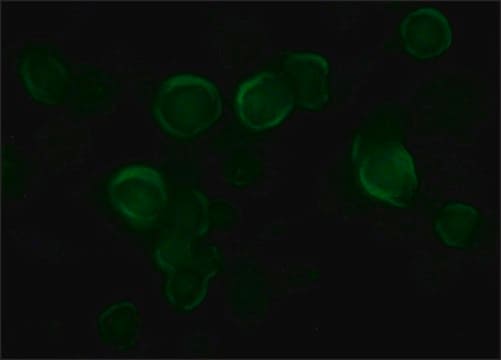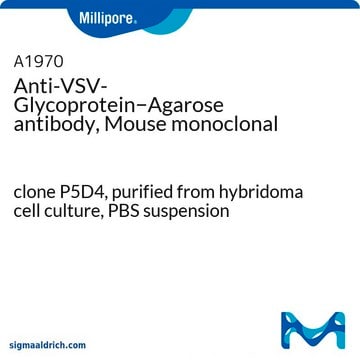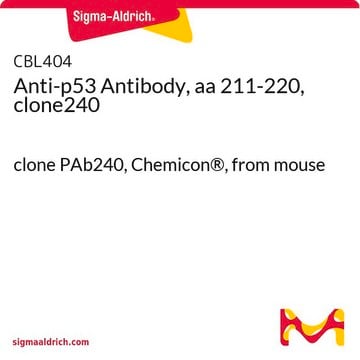추천 제품
생물학적 소스
mouse
결합
unconjugated
항체 형태
ascites fluid
항체 생산 유형
primary antibodies
클론
P5D4, monoclonal
포함
15 mM sodium azide
기술
immunocytochemistry: suitable
immunoprecipitation (IP): suitable
western blot: 1:100,000 using whole cell extracts expressing VSV-G tagged fusion protein
동형
IgG1
배송 상태
dry ice
저장 온도
−20°C
타겟 번역 후 변형
unmodified
유사한 제품을 찾으십니까? 방문 제품 비교 안내
특이성
The antibody recognizes an epitope containing the five carboxy-terminal amino acids of VSV Glycoprotein. In infected cells, the antibody localizes the immature forms of VSV-G in the rough endoplasmic reticulum (RER) and in the cisternae of Golgi complex, as well as mature VSV-G at the cell surface and in the budding virus. The antibody does not stain the secreted form of VSV-G which lacks the membrane and the cytoplasmic domain. This antibody has been used for studies on the role of the cytoplasmic domain on newly-synthesized VSV-G during transfer to the plasma membrane and cell surface, using micro-injected antibody, immunoblotting, immunoprecipitation, immunocytochemistry and immunoelectron microscopy. The antibody has been used for the detection, immunoprecipitation and immunocytochemical staining of exogenously introduced constructs tagged with the carboxyl-terminus of VSV-G. This tag does not interfere with the function of the studied protein and can be specifically recognized by the P5D4 antibody without cross-reaction with any endogenous protein.
면역원
synthetic peptide containing the 15 carboxy-terminal amino acids (497-511) of Vesicular Stomatitis Virus Glycoprotein (VSV-G), conjugated to KLH.
애플리케이션
Applications in which this antibody has been used successfully, and the associated peer-reviewed papers, are given below.
Flow cytometry/Cell sorting (1 paper)
Flow cytometry/Cell sorting (1 paper)
저장 및 안정성
For continuous use, store at 2 °C to 8 °C for up to one month. For extended storage, freeze in working aliquots. Repeated freezing and thawing is not recommended. Storage in "frost-free" freezers is not recommended. If slight turbidity occurs upon prolonged storage, clarify the solution by centrifugation before use. Solutions at working dilution should be discarded if not used within 12 hours.
면책조항
Unless otherwise stated in our catalog or other company documentation accompanying the product(s), our products are intended for research use only and are not to be used for any other purpose, which includes but is not limited to, unauthorized commercial uses, in vitro diagnostic uses, ex vivo or in vivo therapeutic uses or any type of consumption or application to humans or animals.
Not finding the right product?
Try our 제품 선택기 도구.
Storage Class Code
10 - Combustible liquids
WGK
nwg
Flash Point (°F)
Not applicable
Flash Point (°C)
Not applicable
시험 성적서(COA)
제품의 로트/배치 번호를 입력하여 시험 성적서(COA)을 검색하십시오. 로트 및 배치 번호는 제품 라벨에 있는 ‘로트’ 또는 ‘배치’라는 용어 뒤에서 찾을 수 있습니다.
Ying Zhu et al.
Biomedical microdevices, 11(3), 565-570 (2009-01-15)
The plaque assay has long served as the "gold standard" to measure virus infectivity and test antiviral drugs, but the assay is labor-intensive, lacks sensitivity, uses excessive reagents, and is hard to automate. Recent modification of the assay to exploit
Lindsey R Robinson et al.
Journal of virology, 90(7), 3640-3649 (2016-01-23)
Endogenous retroviruses (ERVs), the majority of which exist as degraded remnants of ancient viruses, comprise approximately 8% of the human genome. The youngest human ERVs (HERVs) belong to the HERV-K(HML-2) subgroup and were endogenized within the past 1 million years.
Mingli Qi et al.
PLoS pathogens, 9(4), e1003278-e1003278 (2013-04-18)
The incorporation of the envelope glycoprotein complex (Env) onto the developing particle is a crucial step in the HIV-1 lifecycle. The long cytoplasmic tail (CT) of Env is required for the incorporation of Env onto HIV particles in T cells
Yongxiang Zheng et al.
Nucleic acids research, 43(11), e73-e73 (2015-03-15)
With the aim of broadening the versatility of lentiviral vectors as a tool in nucleic acid research, we expanded the genetic code in the propagation of lentiviral vectors for site-specific incorporation of chemical moieties with unique properties. Through systematic exploration
Sanne W A Reulen et al.
BMC biotechnology, 9, 66-66 (2009-07-22)
Classical bioconjugation strategies for generating antibody-functionalized nanoparticles are non-specific and typically result in heterogeneous compounds that can be compromised in activity. Expression systems based on self-cleavable intein domains allow the generation of recombinant proteins with a C-terminal thioester, providing a
자사의 과학자팀은 생명 과학, 재료 과학, 화학 합성, 크로마토그래피, 분석 및 기타 많은 영역을 포함한 모든 과학 분야에 경험이 있습니다..
고객지원팀으로 연락바랍니다.








